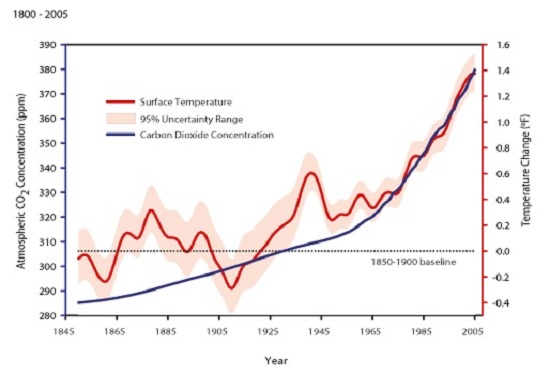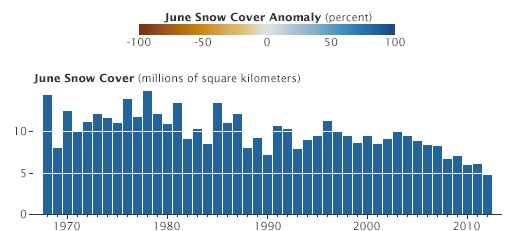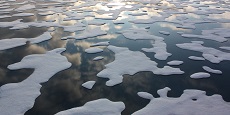In the comments thread of the post Is methane hydrate out-gassing going to kill us all? BilB linked to an article The Global Impacts of Rapidly Disappearing Arctic Sea Ice by Peter Wadhams, who is professor emeritus of ocean physics at Cambridge University, a sea ice specialist with 46 years of research on sea ice and ocean processes in the Arctic and Antarctic with more than 50 expeditions to both polar regions under his belt.
He worries about what is happening in the Arctic, and after revisiting my post Reconciling estimates of climate sensitivity, I worry too. Not so much about the extinction of the human race, or about abrupt catastrophic climate change, rather how the earth system is going to end up in the long term after we extract much of carbon sediments deposited over hundreds of millions of years and inject them back into the atmosphere within the space of about a century.
As exhibit A to get us going, here is a graph, obviously smoothed, to show that something is happening:

It’s Pew Centre graph I had on file from 2006, compiled from data from official sources.
I could show you one that also has solar irradiance variations, but I assure you it has no relevance.
First, what is Peter Wadhams saying about the Arctic?
The basic fact is that the sea ice is disappearing, probably by as much as 75% by volume in the last half century. Thinner ice is more susceptible to breaking up from wave action and storms, which increases the exposure of ice to water, and hence melting. Similarly increased waves make ice harder to form in the autumn.
He thinks we could have open waters in the Arctic at the peak of the summer season, usually September. This allows more heat to be absorbed by water, which is darker than ice. Such reflectivity is termed the ‘albedo’ effect. From that point, the ice-free season will no doubt expand to three to four months a year, and eventually to five months or more.
Wadhams links to other research which found that the Arctic albedo effect is 25% as large as that due to the change in CO2 during the period 1979 to 2011.
A similar issue is at work with snow cover on Arctic land, as this graph shows:

Today snow cover loss in Arctic lands amounts to several million square miles. Run-off from the melting snow and the rivers now flows through warmer lands, yielding warmer input to the ocean.
Wadhams calculates the magnitude of this effect as similar to the ocean albedo effect above.
Then, he says, the warmer atmosphere over the Arctic holds more water vapour, as much as 20% more. Water vapour is the biggest factor of all in the greenhouse effect.
Then he talks about melting in Greenland, advising that:
- Greenland is now the largest single contributor to global sea level rise, its melting ice cap adding some 300 cubic kilometres (72 cubic miles) of water per year to the ocean.
I didn’t know that, I thought thermal expansion was still the biggest. Sooner or later, however, ice sheet decay was always going to be the main game. Over the next few centuries I understand more melting is likely to come from West Antarctica than from Greenland.
Finally, Wadham comes to the biggest worry of the lot as he sees it, the release of seabed methane from the continental shelves of the Arctic Ocean. He fears that a pulse of up to 50 gigatons of methane, some 8 percent of the estimated stock in the Arctic sediments, “could be released within a very few years, starting soon” giving in short order a boost of one degree Fahrenheit to global warming. He says that the worry is the continental shelves around the East Siberian, Kara, Laptev, and Barents seas which are only 130 to 300 feet deep. They used to be covered by ice, but are now exposed to direct warming. He says:
- This release is already causing global methane levels to rise after being flat through the early years of this century.
Other scientists disagree finding other sources most likely, but he says the ones who worry about methane are those who have actually worked on observations.
Then, he says, permafrost could yield as much again.
Obviously I can’t arbitrate on the methane matter, but longer term risk must surely remain, and there is plenty there other than methane to worry about.
In my review of climate sensitivity I linked to a post by David Spratt, who says:
- A 2011 study, for example, found that if the Arctic were ice-free for one month a year plus associated ice-extent decreases in other months then, without taking cloud changes into account, the global impact would be about 0.2ºC of warming. If there were no ice at all during the months of sunlight, the impact would close to 0.5ºC of global warming.
But his stunner was this.
Recent reviews of climate sensitivity (the warming that would result from a doubling of atmospheric greenhouse gas levels) showed a likely value of about 4°C, with a lower limit of about 3°C. However, no account was taken of “slow” feeedbacks:
- such as the decay of large ice sheets, changes in the carbon cycle (changed efficiency of carbon sinks such as permafrost and methane clathrate stores, as well as biosphere stores such as peatlands and forests), and changes in vegetation coverage and reflectivity (albedo).
There is plenty to worry about what is happening in the Arctic. James Hansen did take those issues into account in his 2011 paper Earth’s Energy Imbalance and Implications, using paleoclimate data to enhance information from climate observations and models.
Hansen’s treatment is complex, but he gives four categories of climate sensitivity. When secondary longer-term feedbacks are taken into account Earth System Sensitivity (ESS), which can play out over millennia, is more likely to be around 6°C. As a consequence he repeated his 2007 recommendation that we reduce atmospheric levels of CO2 to 350ppm as soon as possible for a safe climate.
Wadhams says:
- What is needed today is a widespread global campaign to actually remove carbon dioxide from the atmosphere using techniques like direct air capture. In my view, initiatives to devise economically acceptable methods for carbon dioxide removal from the atmosphere should be the most important concern of science and technology. The success of these efforts will mean the difference between the prospect of a positive future for mankind and the certainty of a descent towards climate-driven chaos.


Thanks for this evaluation, Brian. I am alarmed in the manner that requires a lot more research and information quickly to determine whether to be less or even more alarmed.
My wife and I had dinner with family friends on the weekend, one of whose father was an LNP MP in the 1990’s and reacted strongly to my dismissal of Trump as a buffoon. “Don’t you run down our Trumpie, he is going to do this that and the other thing”. The unquestioning ill informed vehemence of the support was a little off putting, particularly as we were all Australians.
I got a similar reaction from a lawyer who was talking to the NSW Attorney General at a Liberal Party function I attended, where I was talking about people you go into business with who turn out to have mental conditions supporting my argument with “Abbott is clearly a full on Sociapath (drew a nervous laugh) and Trump is most of that as well”. The lawyer moved quickly into “Wait he may yet surprise you, Trump has only just begun (paraphrased)”. The tribal nature of this seems to blot out all rational thought, at least publicly.
The only good news on the week end is in the NYT article on the Murdoch boys now firmly grasping the reins of daddy’s empire. It seems the wives are far more ecologically grounded and at least one son is environmentally knowledgeable. However it might take them quite a while to discover that the Australian is still running, …. and theirs.
We must turn concern into action, starting with challenging our politicians one by one to declare their positions and the sources of their (faux) knowledge.
BilB, thanks for that. I’ve added a bit to the second last paragraph, so that it now reads:
My local MP is Stephen Miles, environment minister for the state labor government. I’m a bit guilty I haven’t gotten into him about supporting Adani, but I’m not a natural political stirrer and I suspect he knows it’s a really bad idea.
Our federal MP is Liberal Jane Prentice. Talking to her about anything would be a complete waste of time.
I see what you mean.
The approach there would be to get an appointment, this is your right, then talk to here asking about her long service in public life and how that gives her credibility. Next show her a printout of the Wadham article talking about his decades of involvement with in the Arctic and how that gives him credibility in his field. Then talk about his concerns, which have become your concerns, and that protecting our environment must be apolitical.
Prentice will then begin to gush about the LNP’s comprehensive Climate Action plan to which the response might be “do you personally believe that is sufficient to prevent this collapse in the Arctic?” Have a copy of Peta Credlin’s admittance that Abbott’s Carbon attack was entirely political.
I am prepared to go to Political Party functions to have the opportunity to talk and influence as much as I can. Most of the people I spoke to at the last one were receptive to new information. Its just a matter of putting it in context.
Brian: My understanding is that losing ice cover in the arctic will slow the gulf stream which is likely to make Western Europe and the Eastern US colder, not hotter. I also recall reading somewhere that, in the past an ice free arctic led to surge in plant life in the Arctic ocean helped along by all the minerals being washed into the Arctic. The growing and dying of the Arctic ocean reduced CO2 in the atmosphere .
Also recall reading somewhere that the Arctic ocean was ice free during the ice ages. It was all that atmospheric moisture coming from the Arctic that drove the building up of the ice fields.
In the meantime reducing population increases and slowing changes in atmospheric greenhouse gases improves the chances of human survival during climate disruptions.
When you say it like that in a single breath, JohnD, it sounds like a very appealing picnic. Some citations would be good.
My expectation is that these are interpretations from a very different world over a very long geological scale time frame, not the rapid burst Trump style “climate action” culminating in a quick trip back to climate as usual.
I’m pretty sure that the colder Europe part of the Atlantic current shutting down is a local redistribution of energy with no change to the rate of heating in a globally heating planet. But I would be keen to see your source material.
BilB, good advice. My sister-in-law who is in the same electorate was talking about making an appointment.
John, I don’t think there is any simple relationship between Arctic ice and the Gulf Stream. I recently came across this article, albeit from 2012, which found that during the Eemian 120Kya the Arctic ice stayed put while temperatures were similar to now, or a bit higher, and sea level was 6-9m higher.
I’m still planning a post that looks at the cold blob near Greenland, but suggests that what happens in the Great Southern Ocean and Antarctica will be more important, and ironically surface temperature almost everywhere could get colder while the ocean continues to soak up heat and the sea continues to rise.
Sorry Bilb but it is a long time since i read what i am quoting and haven’t got the citations. Complex covers it all I think.
BilB, there is not a lot step-wise about the global ocean heat graph I posted on the Cyclone Debbie thread:
It’s relentless, and that’s where 93% of the heat goes.
As Roger Jones says, the increases in surface temperature come stepwise as heat moves around the planet, with different steps in different regions. I suspect things could have worked out differently in different interglacials, but I don’t really know much about it.